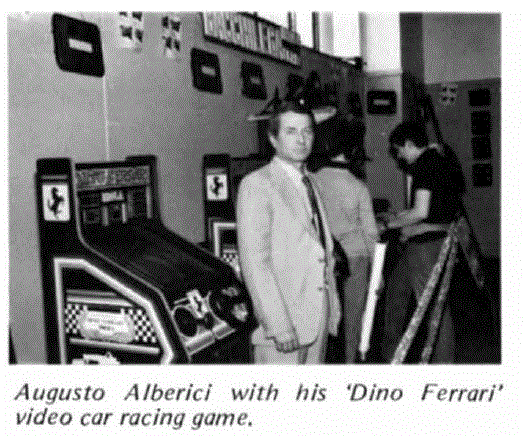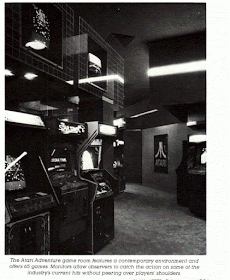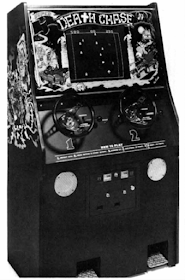One of the most oft-told
stories from the annals of video game history involves the first Pong game and
its legendary "malfunction". You've probably all heard this one. Ted Dabney
and Al Alcorn put their prototype Pong game on location at Andy Capp's Tavern.
Some time later (from the next day to about two weeks, depending on the account,
though the latter seems to be the more accurate timing) the bar's owner, Bill
Gattis, calls Alcorn and tells him to come and fix his "malfunctioning"
machine. A worried Alcorn hurries over to Andy Capp's to take a look and when
he opens up the machine he breaks into a broad grin as he sees the source of
the problem. The coinbox is so full that quarters have backed up all the way
to the coin slot.
The story is told in just
about every history of video games out there and with good reason - it's a
great story. But did it actually happen?
I was recently reading an
article on the history of Gottlieb in the November, 1978 issue of Loose Change
magazine (a magazine aimed at slot machine collectors) when I came across the
following passage about the early pinball game Bingo (quick summary - Bingo was released in 1931 by the Bingo
Novelty Company. That summer, they sold the rights to Gottlieb. Gottlieb later
renamed the game Bingo Ball and
followed it up with Baffle Ball). On
to the story…
"The following story is
one of many of this type that were often told about BINGO. The tale usually
tells of a man, during the depression, who invested his last dollars in a BINGO
machine. Friday afternoon, after installing the machine in a bar owned by a friend,
the man returned to his dingy hotel room to contemplate how he could come by funds
enough to provide food that would last until the end of the week. It was to be
Friday of the coming week he was to return to his friend's bar, empty the BINGO
game of pennies and split the week's take. To his dismay, Saturday night about midnight,
an acquaintance of his friend began pounding hard enough to knock the rickety
hotel room door off of its rusty hinges and informed him that his coin operated
machine was malfunctioning. Down hearted at the thought that his last dollars
had been wasted on a device that would break down on its second night of
operation, the man accompanied the messenger back to the bar. Upon opening his
BINGO game the man was elated to discover that the machine's malfunction was due
to the fact that machine was so glutted with pennies that it simply would not accept
another coin!"
Sound familiar? Of course,
the fact that this story has many close similarities to the Pong story doesn't
meant the either or both of them didn't actually happen. Such an event could
have occurred more than once.
But there's more. In the
book All Your Base Are Belong To Us, former
Nolan Bushnell assistant Loni Reeder claims that someone from Atari went to
Andy Capp's and stuffed the coin box.
Whether the claim is true or
not, I can't say. Personally, it doesn't really ring true with me. First of
all, how exactly did they do this. Did they break in at night? Did they have a
key? It seems hard to believe they could have done it during business hours
without Gattis noticing (unless the machine was in a back room and out of
sight). Or maybe Gattis was in on it? (if so, who was the target audience). And
what did they hope to accomplish? If it was a publicity stunt, who would have
known about it? Was there some kind of coin-op grapevine that would have spread
the word throughout the city?
As far as I can recall, the
incident is not reported in Curt Vendel and Marty Goldberg's Atari Inc. Business is Fun - and Reeder
was their editor - which leads me to believe that either they had knowledge
that the story (the box-stuffing story, that is, not the original story) was
false or that they couldn't find a second source to back it up.
I don't think either the
Bingo story or Reeder's claim is enough to render the original story "BUSTED".
Al Alcorn seems pretty insistent that it happened (I don't recall if any other
witness has ever confirmed his story or not or if he was the only one there -
besides Gattis - and I don't think anyone's tracked him down).
Here's a couple of others from Loose Change.
First, the C.A. Robinson showroom in 1977 (C.A. Robinson was one of the country's largest distributors):
And the same showroom in 1943
Here's an interesting sign from the 1982 ATE show in London (the Amusement Trade Exposition was one of the largest coin-op shows in the world at the time). Copyright laws in Great Britain wren't as defined as they were in the U.S. This sign is from Competitive Video's booth.
I think this game actually is on TAFA.
Zaccaria's Sea Battle at the 1980 Milan Fair (another Euro coin-op show).
Speaking of the Milan Fair, here's Bacchilega's (an Italian manufacturer) Dino Ferrari, from the 1981 Milan Fair (Augusto Alberici also designed Imola Grand Prix).
The following screenshots are from Chameleon and Amazon - two games made for a 1984 "system game" called Select-A-Game made by Bresnahan Technologies of Denton, TX. I don't know if the system ever made it into production. There was also a third game for the system called Airport and they planned to release more.
Finally, to end on another Atari note, here's a shot from the first Atari Adventure, opened in November, 1983 in the Northwest Plaza mall in St. Louis. Atari Adventure was a combination arcade and computer learning center.





























